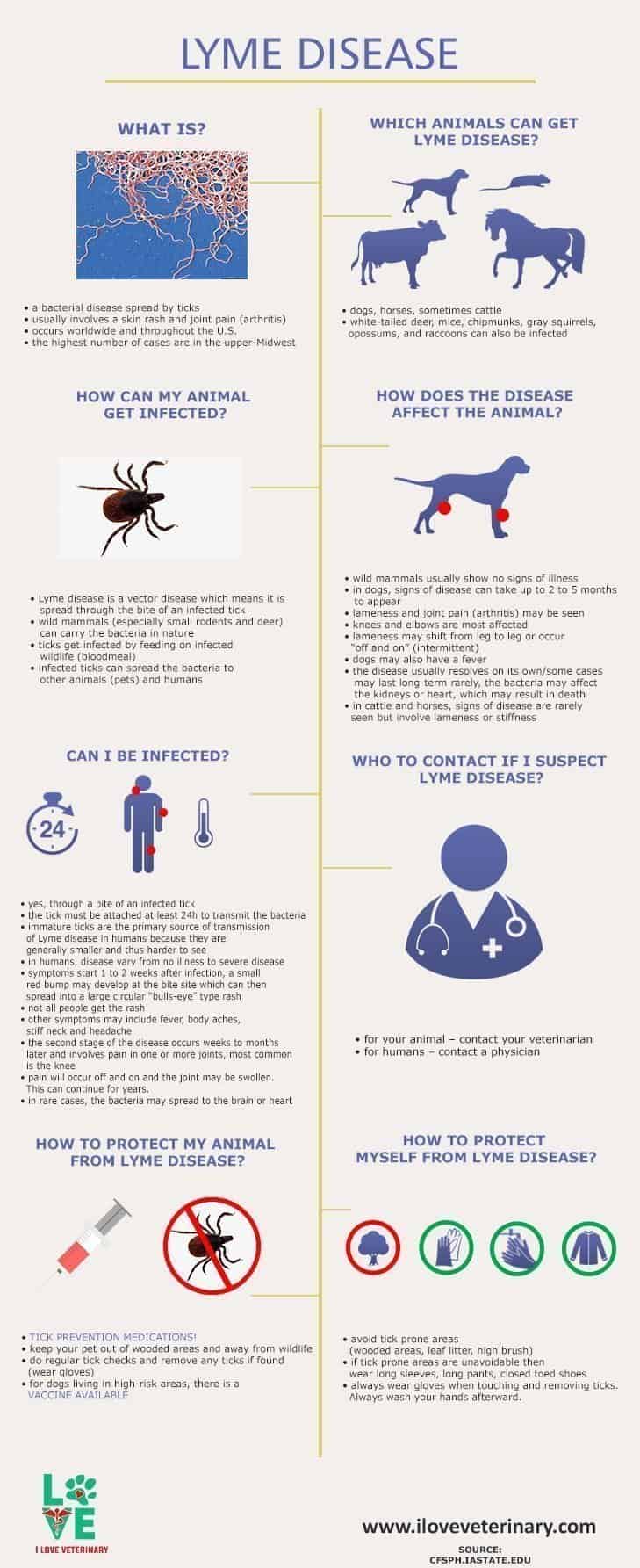
Custom Search
Lyme Disease
Posted by I Love Veterinary
8-23-10
Posted by I Love Veterinary | Feb 5, 2018 | Animal Diseases, Infographics
What is Lyme disease?
- a bacterial disease spread by ticks
- usually involves a skin rash and joint pain (arthritis)
- occurs worldwide and throughout the U.S.
- the highest number of cases are in the upper-Midwest
What animals can get Lyme Disease?
- dogs, horses, sometimes cattle
- white-tailed deer, mice, chipmunks, gray squirrels, opossums, and raccoons can also be infected
How can my animal get infected?
- Lyme disease is a vector disease which means it is spread through the bite of an infected tick
- wild mammals (especially small rodents and deer) can carry the bacteria in nature
- ticks get infected by feeding on infected wildlife (bloodmeal)
- infected ticks can spread the bacteria to other animals (pets) and humans
How does the disease affect the animal?
- wild mammals usually show no signs of illness
- in dogs, signs of disease can take up to 2 to 5 months to appear
- lameness and joint pain (arthritis) may be seen
- knees and elbows are most affected
- lameness may shift from leg to leg or occur “off and on” (intermittent)
- dogs may also have a fever
- the disease usually resolves on its own/some cases may last long-term
- rarely, the bacteria may affect the kidneys or heart, which may result in death
- in cattle and horses, signs of disease are rarely seen but involve lameness or stiffness

Can I be infected?
- yes, through a bite of an infected tick
- the tick must be attached at least 24h to transmit the bacteria
- immature ticks are the primary source of transmission of Lyme disease in humans because they are generally smaller and thus harder to see
- in humans, disease vary from no illness to severe disease
- symptoms start 1 to 2 weeks after infection, a small red bump may develop at the bite site which can then spread into a large circular “bulls-eye” type rash
- not all people get the rash
- other symptoms may include fever, body aches, stiff neck and headache
- the second stage of the disease occurs weeks to months later and involves pain in one or more joints, most common is the knee
- pain will occur off and on and the joint may be swollen. This can continue for years.
- in rare cases, the bacteria may spread to the brain or heart
Who to contact if I suspect Lyme Disease?
- for your animal – contact your veterinarian
- for humans – contact a physician
How to protect my animal from Lyme disease?
- tick prevention medications!
- keep your pet out of wooded areas and away from wildlife
- do regular tick checks and remove any ticks if found (wear gloves)
- for dogs living in high-risk areas, there is a vaccine available
How to protect myself from Lyme Disease?
- avoid tick prone areas (wooded areas, leaf litter, high brush)
- if tick prone areas are unavoidable then wear long sleeves, long pants, closed toed shoes
- always wear gloves when touching and removing ticks. Always wash your hands afterward.
- https://iloveveterinary.com/blog/lyme-disease/
